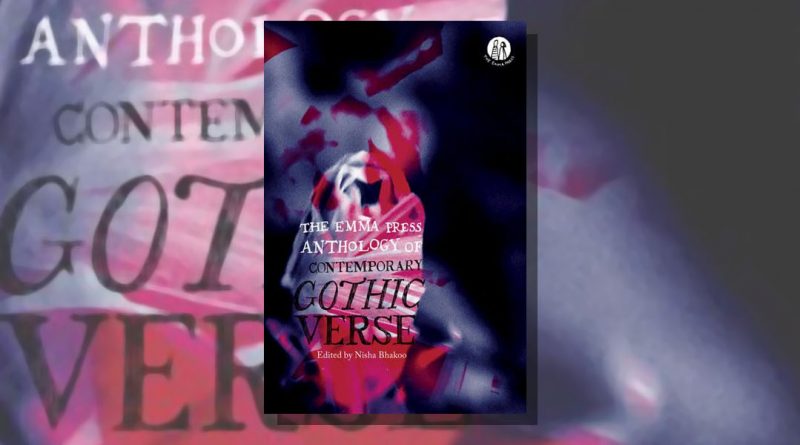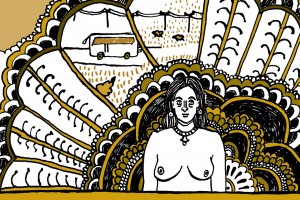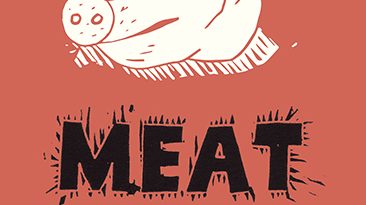The Emma Press Anthology of Contemporary Gothic Verse edited by Nisha Bhakoo
-Reviewed by Pam Thompson-
What is contemporary gothic? Editor Nisha Bhakoo’s aim in selecting poems for this anthology was ‘to showcase poems that pointed to the uncanniness of our present time, giving traditional gothic tropes a compelling, contemporary flavour’. For Sigmund Freud, locating the uncanny meant finding the strangeness in the ordinary. For traditional gothic tropes we might expect a psychological or supernatural dimension: ghosts and other weird beings, ruined buildings, strange happenings, darkness. Bhakoo also wanted to find ‘daring poems that challenged patriarchal ideals and the current social order’ and where the possibilities of the gothic genre allowed for the presentation of ‘culturally silenced emotions and ideas’ and exploring all sorts of complexities.
Dolls feature strongly as uncanny ‘others’. Angela Readman’s prose poem, ‘The Doll’ is precise, vivid and thrilling:
I made a doll of myself. A knit of buzz-cut Barbies and dresses
that didn’t fit. Stick-legged and prime-ribbed, to give her skin
was like pouring cold milk. I stood back and looked at this doll,
the same size I was, her cup hands and small feet. I lived with
her for years before I applied a face.
I particularly liked the descriptions of the doll’s heart, ‘A catcher’s mitt, a Hulk fist clutching a robin’s egg, a smidge of popped bubble-gum and glue.’ While the woman ‘stayed in bed’ the doll lived her life, to the extent that people messaged her to say ‘how lovely it was to see me, work with me, kiss me and wake with me naked.’
In ‘The Doll Ritual’ by Angela Gardner, the practices being described are disturbing and macabre:
The afterlife needs no vents
for we seal their mouths and nostrils.
It’s always a clampdown, always a closed city.
We never quite know who the ‘we’ are and the reason for the ceremony. Childhood is cruel: ‘Toss them (the dolls) careless into boxes or hang them / with the dolls on the chairlift.’ Is this some sadistic revenge on elders? Are these actually children? Whatever, the pleasure is evident, ‘ the ritual is gorgeous, its ceremony, its flop / floozy whirlpools’, and although the ending contains instructions to protect yourself, ‘Fit your own gas mask’, there is apparent logic but much cause for alarm, touching on our contemporary fears about online surveillance ‘check your mouthpieces / and nosebleeds for already the algorithms / are clamouring’.
Several poems are situated in a particular time in history, around a specific event or featuring a character from the past. I was intrigued to find out more about the Haworth Gala, 1906, that prompted Charlotte Eichler to write ‘Balloonist’, a sparsely evocative poem, about a female balloonist:
looks down on the village,
pictures it wilder –
black hats a penguin circus-
The Old White Lion
roaring her name –
all those extra hearts
to bloody her.
Lily Cove was the main attraction at the gala. She was supposed to jump from the balloon and ascend using a parachute but she somehow became detached from it, plunged to the ground and was killed. There was speculation about what happened – was it a jealous lover or was she trying to avert further danger? We get a picture of a girl who wanted more excitement in her life, ‘always looking for the ropes’, and a frisson of mystery and risk.
Eva Isherwood-Wallace reckons with the idea of the imaginary childhood friend in ways which are both troubling and ecstatic, ‘Today we dress as heroes’. The poem’s premise is puberty; conflagration of contending hormones; the body’s sexual unruliness, ‘I raise security and car alarms just by walking past’, ‘At fourteen I cut off all my hair. I become a lightning rod.’ Joan, a presiding spirit who exists outside gender, leads this young person by example: ‘She kneels under the folds of a red dress, rough as static, and burns out of it.’
It is good to see translated poetry represented. In ‘Bluebeard Possibilities’ (translated from the Spanish by Lawrence Schimel) Sophía Rhei presents us with nine tweaks of the traditional Bluebeard story. An ogress step mother replaces Bluebeard in the first part and eats disobedient children who turn out to be poisonous. in another part, after ‘after poking all the wives with a needle to see if one of them screamed. / But none of them did. So he grew bored and went to dead. / She (the girl) opened her eyes, saw none of the wives were dead.’ The result is pleasingly subversive. Typographical spacing of sections, with ‘…oooOOOooo …’ as a kind of refrain, allows us to pause, to exclaim, to make our own haunted noises.
In ‘My Shadow’ by Lajos Szórádi (translated from the Hungarian by Joe Váradi) the person’s shadow is a beneficent and helpful presence, ‘she could stand / as I lay in sweet repose / If I shut the lights / she’d still be there.’ Sue Burge’s ‘Golem – Citations Needed’ has ‘translated’ the depiction of the Golem, ‘In Jewish folklore, a golem is an animated anthropomorphic being that is magically created entirely from inanimate matter’, from listings about it in Wikipedia to create its mythology. It reads both as personal testimony and a series of reminiscences by others with numbers in the text directing us back to the original citations:
Creature thumbed and smoothed into being like a pot from the
mudbanks of the Vlatava, (1) your rabbi master incises your torso
with lore, stoppers your mouth with secret utterances. Your brow
sweats like overcooked clay, newly tattooed emet, emet
emet (2).
Other poems that stood out for me were Richard Yoder’s ‘The Ordeal’ where dark family dynamics play out and reminded me, in places, of Emily Dickinson, ‘I drowned my mother in another life / at one of the empty spaces of the world’; Suzanna Fitzpatrick’s unnerving, ‘Closing Number’, ‘ I stare at the spot-lit smoke, wonder / whose form it will take …’, and the two prose poems by Anna Kisby that close the anthology, ‘The Watchmaker’s House’, ‘It’s so 3D, his ghost of a house’, and ‘Pumpkin Pie, I Tell No Lie’, ‘The year I turned nine, Emily the Poet set fire to the attic and burned her tiny notebooks’. Prose poems or flash fiction? Both, probably. They are suitably rich and creepy.
The standard is high; the brief, set out by the editor, happily fulfilled. The contemporary gothic is excitingly defined and redefined in the poems in this collection.





